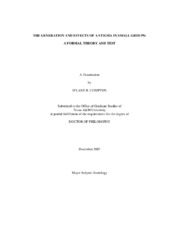| dc.description.abstract | Drawing from the vast literature on stigmas, theories of status generalizations
and affect, this study employs a formal framework to delineate among different kinds of
stigmas and different processes by which they might operate. This study then considers
the case of a particular type of stigma, a behavioral stigma, a label that is obtained from
past behavior. The formalization distinguishes how knowledge of a particular type of
stigma operates through group members who then cast an “other” into a stigmatized role
with special attention to affect and behavior of the stigmatized individual and the other
group members. Additionally, I am able to study the developmental process of stigma
because, in the particular theoretical case I consider, the stigmatized individual is
initially unaware of the stigma.
The findings indicate that stigma were created and did have an effect on
individuals and groups. While the observable power and prestige effects were much
more pronounced for measures of content versus measures of amount of interaction stigmatized groups were characterized by more disapproval, fewer agreements and more
interruptions than were nonstigmatized groups. Further, those who were stigmatized had
less influence than other group members. In terms of feelings, there was support for the
hypotheses suggesting that stigmatized individuals rate both themselves and their groups
more negatively than do nonstigmatized group members. Also, those who were not
stigmatized rated the stigmatized person more negatively than others. While there were
no significant differences between Stigmatized and Control groups relative to happiness
or group cohesion and efficiency, those in the Control groups were more committed to
their groups than were those in the Stigmatized groups.
This study contributes to the large literature on stigma by examining one kind of
stigma. It also contributes to several established literatures in social psychological
theory. This study has implications for the power of the social construction of stigma
and consequently for the power of social construction in the dismantling of stigma. | en |


